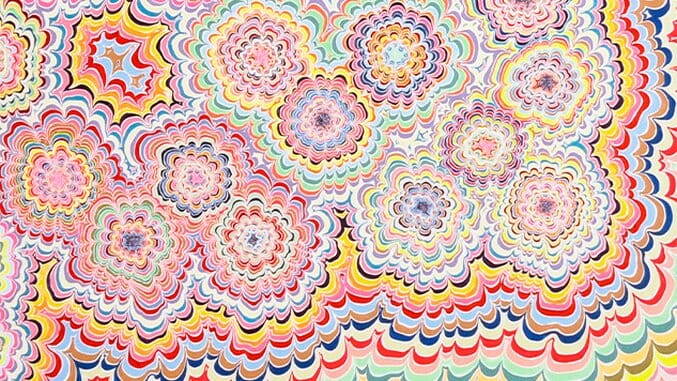This Is Your Art on Drugs: Kelsey Brookes
Works courtesy of Kelsey Brookes and Quint Gallery
It’s hard to say whether painter Kelsey Brookes is a scientist working in an art studio or an artist working in a science lab. He focuses on the structure of hallucinogenic and pharmaceutical drugs and the visual patterns they create in our brains in a series of colorful, insightful paintings. Each canvas fascinates because it combines the beauty of art with the measurements of science.

The paintings begin with molecular line diagrams — the visual shorthand chemists use to show where each atom is located within a larger molecule. Brookes transfers the diagram onto his canvas, places a dot at the location of each atom, and outlines it repeatedly with different colors until his painting surface is full. He says the approach “creates an aesthetically beautiful and empirically derived diagram.”
The paintings are surprisingly grounded, because Brookes creates the structural basis of each by using the repetitive patterns found in molecular formations. The artist worked with motion director Matthew Lawless to explain the process in a delightful short film, which you can see in full here. Understanding the science and skill behind the giant psychedelic works adds even more depth and beauty. The concept is grounded in creating a solid framework that still leaves room to play, to explore beauty while being absolutely anchored in the atomic reality of it all.

Brookes was a scientist before becoming an artist. It will surprise no one to hear he focused his efforts in the molecular and microbiology fields. Brookes stopped doing figurative work after discovering this simple but stylish method of painting. It could be argued that he is still painting figuratively because the subject matter is just molecules and hallucinogenic visions. Seeing his work is a trippy experience. But viewers can take comfort in recognizing the specific scientific structures behind these visual representations of chemical happiness.
Like the specific dots within his paintings, Kelsey Brookes works at the intersection of art and science. Paste reached out to him for his thoughts on how science can help humanity in this tumultuous time.

“I’m particularly interested in the neurotransmitter serotonin and its impact on our general sense of wellbeing. But there are lots of other molecules in the human brain and in our culture that mimic serotonin in some way, and a lot of those are psychedelic molecules such as DMT, psilocybin, LSD, and mescaline. These often elicit crazy visualizations. The way they affect the human visual system looks a lot like the abstract paintings I’ve been working on.
Computer science and biology are our greatest hope for the future of the planet and the life on the planet. The rapid adoption of the fruits of the scientific method have created a negative feedback loop on science itself. In other words, science and technology are progressing faster than the human social system can absorb, and that is causing a backlash.”
Brookes has used his thoughtful painting style to make album covers for the Red Hot Chili Peppers and The Flaming Lips, along with creating visually expansive murals in a number of locations. As for the artist’s next explorations?
“I have been looking into numbers and number sequences in the last 2 years. I’m interested in the hidden patterns and fundamental systems organizing the material world including life. Molecules are a part of that, numbers are an interesting piece as well.”







































